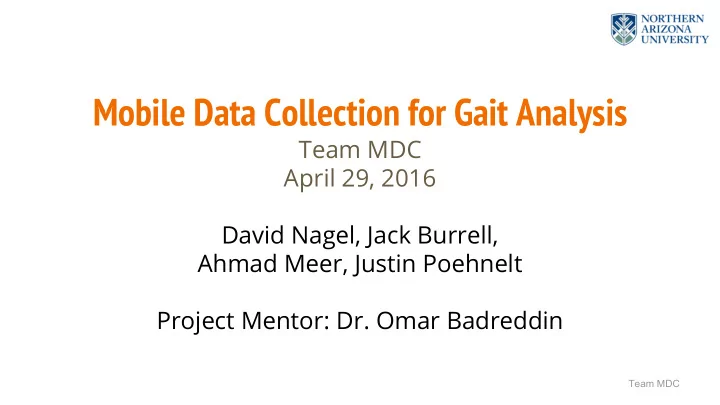

Mobile Data Collection for Gait Analysis Team MDC April 29, 2016 David Nagel, Jack Burrell, Ahmad Meer, Justin Poehnelt Project Mentor: Dr. Omar Badreddin Team MDC
Project Sponsor Dr. Kyle Winfree Department of Informatics and Computing ● The PD Shoe is designed to make simple ● reminders for patients with Parkinson’s Disease. PhD, Biomechanics and Movement Science 2 Team MDC
Data Collection for Gait Analysis Few commercial tools for collecting data on gait. Data often limited to activity level. Existing Wearable Devices: Fitbit ● Jawbone ● Nike+ Sportband ● LifeGait ● 3 Team MDC
Data Collection for Gait Analysis Raw data collection outside of clinical ● setting allows for analysis outputs Stride Duration ○ Foot Strike Pattern ○ Weight Distribution ○ 10 million patients worldwide with PD ● Supports diagnosis and testing of ● treatment effectiveness and other physical therapies 4 Team MDC
Challenging Requirements Requirements elicited from regular meetings with sponsor: Sufficient Granularity of Data ● Time Delta Between Readings of less than 10 milliseconds ○ Near Real-time Analysis of Data ● Automated Data Centralization ● Access to Data for Statistical Packages such as Matlab and Octave ● Standardized Modules Extensible to Many Wearable Devices ● 5 Team MDC
Key Risks Loss of data Server Cannot Handle Power interruptions, network congestion, Number of Requests weak control flow system Potentially 1000 rows to insert every 10 seconds Poor Data Granularity Inefficient hardware or software design Postgresql limits Lag in Data Availability Max Table Size - 32 TB Poor network connectivity Data Synchronization Errors Unsynchronized devices and poorly calibrated sensors 6 Team MDC
Development Process Evolutionary Rapid Development 7 Team MDC
System Overview Four Components Wearable Device ● Mobile Device ● Web Server ● Database ● 8 Team MDC
Wearable Device Teensy 3.2 microcontroller was selected over the Arduino and Photon Modular design with various sensors and components 9 Team MDC
Wearable Device: Database Rows ‘indexed’ by timestamp ● Decoupled from specific sensors ● on device Space requirements reduced by ● 65% compared to CSV format 10 Team MDC
Wearable Device: Control Flow Multiple Tasks Reading from sensors ● Send data to mobile device ● Time synchronization ● Status check ● Stop and start ● 11 Team MDC
Wearable Device: Communication Bluetooth Application Protocol Time synchronization across ● numerous devices Data requests and responses ● Device identification with LED ● and/or vibration Sensor activation and ● deactivation 12 Team MDC
Mobile Device Bluetooth communication with the wearable device WiFi connection to web server Requests data from wearable device since last retrieved timestamp Caches data in a sqlite database until WiFi connection is available Limited to Android platform 13 Team MDC
Web Server NGINX reverse proxy ● Python Flask application ● framework Handles HTTP POST requests ● from mobile device 14 Team MDC
Database Postgresql 9.3 has been selected for this system. Free and Open Source ● GIS Extensions ● Window functions for ● smoothing and cycle detection Entity Relationship Diagram Analysis may be completed using another layer above Postgresql depending on research needs. 15 Team MDC
Project Testing Unit Testing Components & Non-Functional Testing Integration Testing Usability testing with Dr. Winfree’s ● research students Wearable device difficult to test due to ● Evaluate hardware reliability in shoe form ● limited emulation options Other components have available libraries ● and interface mocking Functional Testing Data successfully transferred through ● hierarchy of system Performance and efficiency tests of data ● communication 16 Team MDC
Future Work Statistical Analysis for Detecting ● Current Activity Optimization ● Power efficiency ○ Bluetooth efficiency ○ Data Analysis and Visualization ● Through Web API Embed Wearable Device in Shoe ● 17 Team MDC
Conclusion Centralized and near real-time collection of data for gait analysis to assess treatment impact and improve early diagnosis of Parkinson’s Disease 18 Team MDC
19 Team MDC
Analysis Outputs 20 Team MDC
Sample Data 21 Team MDC
Example Data 22 Team MDC
Wearable Device: Control Flow 23 Team MDC
24 Team MDC
Entity Relationship Diagram 25 Team MDC
Schedule PERT Chart used to determine three major milestones 1. Wearable device assembled, collecting data, and communicating (In testing) 2. Mobile application receiving and storing data (In testing) a. Performance issues over bluetooth b. GUI finalized c. Automation 3. Web server receiving and storing data (In testing) 4. Unit Testing 26 Team MDC
Pert Chart 27 Team MDC
Schedule and Effort Estimation 28 Team MDC
Start Day Slack Time Days Earliest Latest Slack Wearable Device Assemble Hardware 6 0 0 0 Data Storage 15 6 6 0 Control Flow 26 6 21 15 Critical Path Read Sensors 8 6 39 33 Bluetooth Protocol 11 32 47 15 Design 1. Assemble Hardware Bluetooth Protocol 7 0 23 23 2. Data Storage Mobile Device Android Application 4 0 14 14 3. Server Database Android Bluetooth 12 4 18 14 Android Bluetooth Protocol 12 16 30 14 4. Server API Mobile Database 12 21 38 17 Mobile to Server 8 45 50 5 5. Web Application User Interface 6 28 42 14 Data Analysis on Mobile 10 34 48 14 Estimated Days: 58 Command System on Mobile 8 34 50 16 Server and Database Server Database 9 21 21 0 Assumes days for task is average of best Analysis Queries 8 30 37 7 and worst case estimates. Some tasks Server Models/API 15 30 30 0 may require multiple team members. Web Application 13 45 45 0 29 Team MDC
Project Scale 100 readings a second for 30 days on 1,000 Wearable Devices = 172 Billion Rows/month 30 bytes captured 100 times a second on 1,0000 Wearable Devices = 3 MB/second 30 Team MDC
31 Team MDC
Schedule Estimation and Effort Estimation 32 Team MDC
Recommend
More recommend